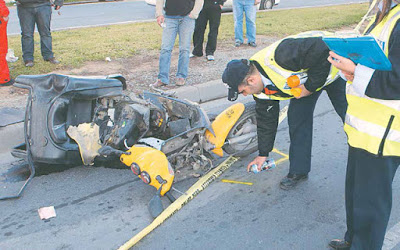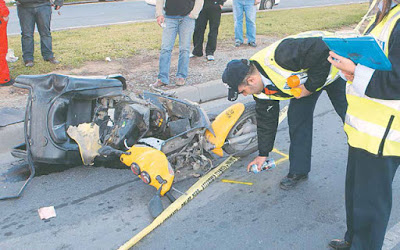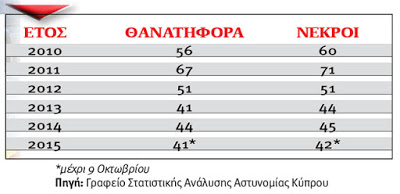The solution to the problem is probably between us. That is, if each of us thinks about how we drive and what mistakes we make while driving, we may be able to reduce traffic collisions.
A police officer involved in the investigation of road accidents has expressed the view that perhaps the most important factor in causing road accidents is disorder. "We are generally unruly in the way we drive and do not obey the traffic code.
We drive recklessly and carelessly. "It's in our culture and mentality," he said. Unfortunately, these characteristics reflect the road behavior of Cypriot drivers, sometimes with fatal results.
However, when Cypriot drivers go abroad and need to drive, the following paradox occurs: They follow all the rules in full, and those behind the wheel have fourteen eyes, driving very carefully. But this picture changes drastically when they return to the streets of our island. In order for the change in our culture and mentality to take place, we need to make an effort from all the actors.
The campaign must start in childhood, in order to consolidate the road consciousness that future drivers must acquire. Also as a more immediate measure - something that is already happening - is the organization of information seminars for national guards. Of course, everything has to be built by the family. No matter how many seminars are held, if the rules are followed by the family guides, then the children will only memorize the bad habits.
However, as pointed out by the experts who dealt with the scourge of traffic in Cyprus, there are typical examples of driver disobedience.
In addition to the very serious offenses that are the speed limit, alcohol consumption and the use of seat belts and helmets, with a walk in urban areas one will find that the violations at the roundabouts and traffic lights are raging.
"Unfortunately, there is a minority of Cypriot drivers who know and use the roundabouts correctly. We see that everyone uses any lane, regardless of the direction they will follow.
We also notice that few drivers use the flashes of their vehicles on the route they will follow. At traffic lights, we see many passing through orange, or starting before the green lights up. "This is a dangerous habit that can cause a violent conflict," said a police officer.
Another point that the Police highlight as an important factor in causing accidents is how well the drivers know the cars or motorcycles they drive.
Now all cars can develop speeds, capable of causing fatality in the event of a collision or rollover. In many cases, especially inexperienced drivers, they only know how to develop high speeds on roads that are not offered, and when an obstacle arises on the road they lose control of the car, they can not stop it resulting in severe collisions.
A similar problem arises with motorcycles, especially those that are large and can take off in a few seconds. Developing such high speeds makes it difficult for motorcycles to stop, and many accidents are caused in turns when riders can not calculate speed and lose control.
In order to deal with the huge social problem with the dozens of people who leave their last breath on the asphalt, from time to time suggestions and proposals were made for increases in penalties, at least for the most serious traffic offenses.
For example, the road safety organization Reaction has proposed increasing penalties for almost all serious traffic offenses. The amount of penalties suggested by Reaction increases gradually, depending on the size of the violation.
The issue of amending some laws related to traffic offenses is also of concern to the Police, however there are changes that run counter to the provisions of the Constitution.
That's why they shout for belts and helmets
Both in daily patrols and in campaigns carried out on a nationwide basis and in each province separately, the controls focus on the use of a seat belt and a helmet.
The targeted campaigns by the Police are not accidental at all. According to the data regarding the fatal traffic accidents, more than half of the drivers did not wear a seat belt, while the same applies to the use of a helmet.
Indicatively, we mention that, out of the 20 dead drivers in 2014, 11 did not wear a seat belt, while there are 3 cases where it was not verified whether they were wearing their seat belt. The other 6 drivers who were killed were wearing their seat belts normally. In the same year, 14 motorcyclists / motorcyclists were killed, of whom 8 did not wear a protective helmet, 2 were not verified whether they were wearing a helmet and only four were wearing their helmets.
The data are similar in 2013 both between car drivers and motorcyclists. In 2013 we lost 19 drivers, 11 of whom did not wear a seat belt. 15 motorcyclists / motorcyclists were killed, 9 of whom were not wearing protective helmets.
If one considers that in some of these cases the riders wore a belt or helmet the motorcyclists, today some of them were probably among us.
Most victims under the age of 25
The under-25 age group is justifiably considered to be the highest risk group for road accidents. In the last two years, most of the dead belong to the age group of 15-24 years. Indicatively, we mention that in 2013, out of the 44 dead, 18 were in the specific age group. In 2014 we had 45 deaths of which 14 were between 15-24 years old.
Another interesting conclusion drawn from the statistics regarding the large number of fatal accidents is the sex of the victims.
From 2010 to 2014 the vast majority of victims are men. In 2010 out of 60 victims 50 were men, in 2011 out of 71 58 were men, in 2012 out of 51 dead 37 were men, in 2013 out of 44 35 were men and in 2014 out of 45 dead 32 they were men.
Most of the women who breathed their last on the asphalt were recorded in 2012, when 14 were killed, while 13 lost their lives in 2011 and 2014.
As for 2015, by the first week of October it appears that 11 of the victims are under 25 years old. Of the 42 dead on the tarmac, 11 were in the critical age group.
Of the victims, 10 drivers or passengers did not wear seat belts, while 6 of the ten dead motorcyclists did not wear helmets.
The numbers for pedestrians are also worrying, as the number of dead reached 11 compared to 10 we had last year.
Deadly alcohol cocktail and driving
Drinking alcohol in combination with driving is the number one cause of fatal accidents. Especially during the years 2010 - 2014, driving under the influence of alcohol was the main cause with a rate of 33,59%.
The second reason, according to data from the Traffic Department of the Cyprus Police, is the careless and careless driving with a rate of 20,08%. This is followed by excessive speed with 12,36% and non-compliance with the left side of the drive.
As for the other causes, driving under the influence of drugs makes an impression with a percentage of 6,18%. The same percentage of the causes of death is the careless pedestrian traffic.
The other reasons are: careless turning right 4,25%, non-priority of vehicles 2,32% and non-compliance with traffic signals 1,93%.
Sunday is the most critical day
Most deaths occur on Sunday. According to the Police data regarding the period 2010-2014, there were 51 fatalities on Sunday, 45 on Friday, 44 on Thursday and 43 on Saturday.
The least occurred on Monday (15). The remaining days 29 and 32 for Wednesday and Tuesday, respectively. In terms of time, between 8 pm and midnight, most fatalities are recorded, followed by between 4 pm and 8 pm.
Pay attention to pregnant women and the purchase of child seats
The alarm bell from time to time is sounded by the Reaction team for pregnant women and child seats. He points out that pregnancy can significantly increase the risk of a female driver getting involved in a road accident, especially during the second trimester, according to recent research.
The study attributes the increased risk to common pregnancy symptoms, such as fatigue, nausea, insomnia, lower back pain and easier distraction. "Statistically, it is estimated that about one in 50 pregnant women will be involved in a road accident at some point.
"Driving during pregnancy is not forbidden, but great attention needs to be paid to some small details for the safety of mother and child," says the Reaction organization.
According to the Reaction road safety team, the law stipulates that children under 150 cm must be transported in the car with the appropriate restraint system, which will be according to their weight. The seat must also comply with ECE R44 / 03 or later (United Nations international standard applicable in all Member States of the European Union). It must include the capital letter E and a number that accompanies the letter E and indicates the country of approval.
Also, the manufacturer must indicate on the mark the upper and lower weight of the child who can use the seat. At the same time, the word "universal" must be written, which means that it is compatible with all vehicles. The driver of the car is responsible for the safe transport of children under the age of 16 and for the use of restraint systems.
. Never buy a child seat that does not carry the above, even if it is at a low or high price. Some cars offer more sophisticated solutions for fastening child seats (isofix), but you still have to follow the manufacturer's instructions for maximum safety.
Πιο The safest place always and for every child is the back seats of the car.
. Adjust the seat to the child each time you move it. Especially during the first year the weight and / or height of the child changes often. Therefore, the child seat must be adjusted accordingly.
Source: Liberal


